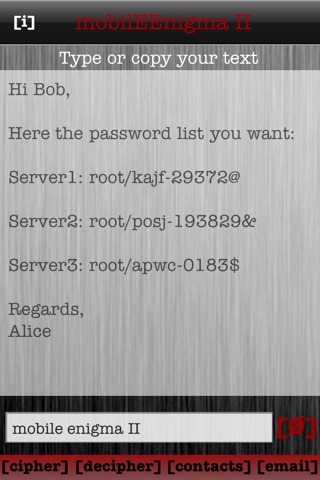
mobilEEnigma II app for iPhone and iPad
Developer: Sylvain Deguire
First release : 14 Jun 2011
App size: 3.93 Mb
mobilEEnigma II is an application to safely cipher any plain text or contacts informations with your iPhone or iPad.
Simply copy or type some plain text, with any iOS language supported, select a secure password or passphrase, then by pressing the [cipher] button, all plain text will be ciphered and already copied to iPhone/iPad shared memory. The only task remain is yo copied the safe text in the app you wish to store it, like a notes, email, message, SMS or any application.
To decipher your ciphered text, copy it to the iPhone memory from the application used, by selecting your ciphered text, then copy it to memory. Go in mobilEEnigma app, type the secret password or passphrase previously used to cipher the plain text, hit the [decipher] button, then you plain text will appear as it has been type in the text view section.
For more details, you may visit mobilEEnigma web site at:
http://www.mobileenigma.com/iphone-ipad/
About mobilEEnigma 2nd generation :
mobilEEnigma II has a new version with a new cipher design formula. That new version can decipher your old text by preceding your cipher text with two uppercase ‘E’, like EE , then it will decipher 1st generation ciphered text.
Any contacts ciphered with mobilEEnigma 1st version will be request by this version to be converted to new version. To convert using 2nd generation formula, enter the password or passphrase that has been used to cipher then, then list them by touching he [contact] button. By selecting a contact already cipher for review, mobillEEnigma will ask to convert them, simply touch [YES], then it will be cipher with second generation formula.
Why a second generation?
The first generation has been design to cipher ASCII text only like english or french language, so this was not working for foreign language like asiatic or arabic language. The second generation is using unichar instead of byte.



